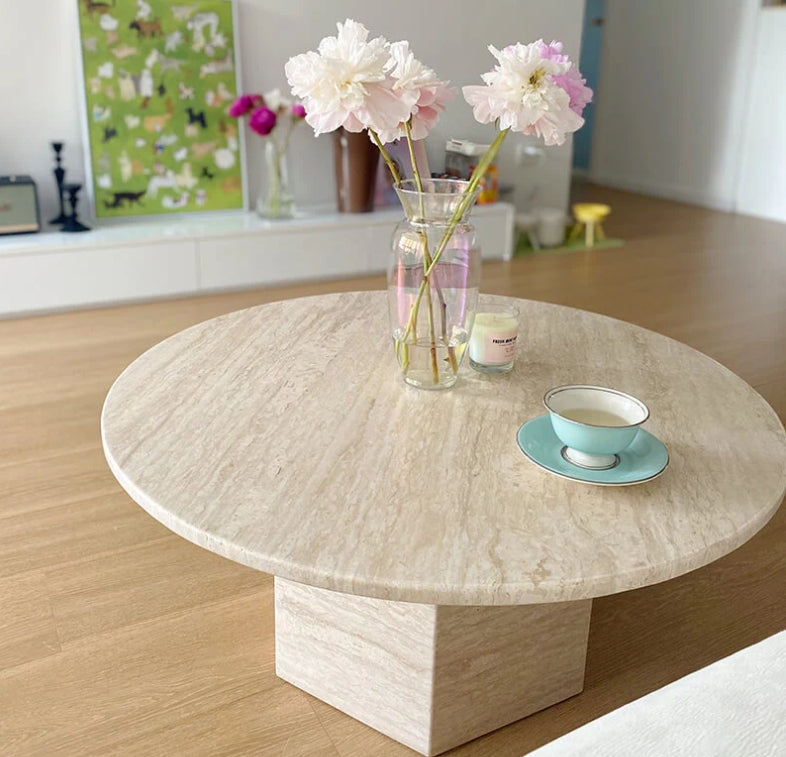What Is Travertine?
Travertine is a natural sedimentary rock primarily composed of calcium carbonate (CaCO₃), formed in mineral-rich hot springs and limestone caves. It is known for its distinctive porous texture, natural earth-tone colors, and timeless aesthetic appeal. Travertine has been used for centuries in architecture and interior design, from ancient Roman buildings to modern luxury homes.
Characteristics of Travertine
1. Unique Natural Texture and Colors
Travertine comes in a variety of warm, earthy hues, including beige, ivory, gold, walnut, and reddish tones. Its surface features natural veins and pores, giving it a rustic and organic look. No two pieces of travertine are identical, making every installation unique.
2. Naturally Porous Structure
One of the defining characteristics of travertine is its porous texture, which results from trapped gas bubbles during formation. These pores can be left open for a more natural look or filled with resin or cement for a smoother finish.
3. Durable Yet Softer Than Granite
Travertine is highly durable, but it is softer than granite and marble. While it withstands wear and tear well, it is more prone to scratching and etching, especially if exposed to acidic substances.
4. Slip-Resistant Surface
Unpolished travertine provides excellent slip resistance due to its porous surface, making it a popular choice for outdoor spaces, pool decks, and bathrooms.
Common Applications of Travertine
1. Flooring
Travertine flooring adds warmth and elegance to both indoor and outdoor spaces. It is commonly used in living rooms, hallways, patios, and pool areas.
2. Wall Cladding & Facades
Travertine’s natural beauty makes it a preferred choice for accent walls, building facades, and fireplace surrounds. It enhances architectural aesthetics while maintaining a timeless appeal.
3. Countertops & Vanities
Travertine countertops are elegant and luxurious, but they require regular sealing to prevent stains and damage from liquids.
4. Outdoor Landscaping
Because of its resistance to temperature fluctuations, travertine is widely used for garden paths, patios, fountains, and poolside paving.
5. Travertine Furniture
Travertine furniture has become increasingly popular in modern and contemporary interior design. It brings a luxurious, natural, and sculptural look to any space. Some common travertine furniture pieces include:
- Coffee Tables & Side Tables – Travertine coffee tables have a striking visual appeal with their natural veins and organic textures. Their solid stone construction makes them highly durable and timeless.


- Dining Tables – A travertine dining table is a statement piece that exudes elegance and sophistication. It pairs well with minimalist and modern decor styles.

- Consoles & Shelving Units – Travertine shelves and console tables add a touch of refinement to entryways and living rooms.

- Benches & Stools – Used both indoors and outdoors, travertine benches and stools offer a sculptural yet functional element to seating arrangements.
Travertine furniture is valued not only for its aesthetics but also for its durability. However, like other travertine surfaces, it requires proper care and maintenance to prevent stains and etching.
Travertine Finishes
Travertine comes in various finishes, each offering a unique aesthetic and functionality:
- Honed – A smooth, matte finish with pores filled, offering a sophisticated and modern look.
- Polished – A glossy, reflective surface that enhances color vibrancy but reduces slip resistance.
- Tumbled – A rustic, textured finish with softened edges, ideal for vintage-style decor.
- Brushed – A rougher surface created by wire brushing, enhancing its natural appearance.
Maintenance & Care for Travertine
To preserve the beauty of travertine, follow these essential maintenance tips:
- Sealing: Apply a high-quality sealant regularly to protect against stains and moisture absorption.
- Cleaning: Use a pH-neutral cleaner to avoid etching and damage. Avoid acidic substances like vinegar and citrus-based cleaners.
- Preventing Scratches: Use felt pads under furniture and avoid dragging heavy objects on travertine surfaces.
Travertine vs. Marble vs. Granite
| Feature | Travertine | Marble | Granite |
|---|---|---|---|
| Hardness | Medium | Medium | High |
| Texture | Porous | Smooth | Granular |
| Slip Resistance | High (Unpolished) | Low | Medium |
| Maintenance | High (Needs Sealing) | High (Acid-sensitive) | Low |
| Best For | Floors, Walls, Furniture, Outdoor | Luxury Interiors | Countertops, Heavy-duty Areas |
Conclusion
Travertine’s natural beauty, durability, and versatility make it an excellent choice for both architectural and interior design applications. Whether used in flooring, countertops, walls, outdoor landscaping, or furniture, it adds timeless elegance to any space. With proper care and maintenance, travertine can last a lifetime while enhancing your home’s aesthetic appeal.

